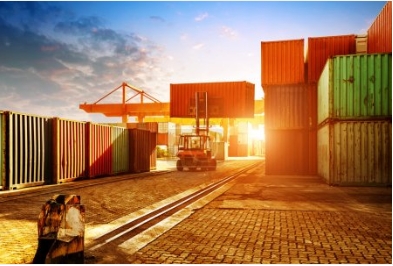
What is a container ?
Containers are a standardised transport unit designed to carry all types of goods. It is a box made up of sheets of metal with dimensions that comply with the ISO standard. The goods are usually transported in 20-foot or 40-foot containers (dry or high cube).
The advantage of the container is that all handling operations can be standardised. Thus, it reduces unit transport and handling costs thanks to the economies of scale it offers. Indeed, the container considerably facilitates transport and handling operations.
The cost of transport operations is optimised with the use of containers, as they are suitable for all modes of land (road/rail/RO/RO) and sea (river, sea) transport. Thus, load breaks are avoided and the transported goods can transit from the supplier to the customer without being unpacked.
It also minimises storage costs by allowing manufacturers and logistics platform managers to stack them to a certain height. The latter offer an excellent storage solution as they have the advantage of being able to be stored outside on the ground as they are weatherproof.
Closing a sea container: Loading / unloading
The loading/unloading and closing of sea or road containers is standard. Containers, unlike semi-trailers, have doors at the rear, with the exception of specific containers with an open roof for example. Leaving aside these exceptional and very rare containers, sea freight is necessarily loaded from the rear.
Therefore, the loading of the containers onto the sea or land transport units has to be done with the help of a crane. These machines are indispensable for transferring the container from one transport unit to another (e.g. from a truck to a container carrier), or to a storage area.
The same applies to the unloading of the container carrier or truck. Cranes are essential for the transfer of storage containers. The iso standard is of great importance here, as it limits the size of the sea containers. Therefore, all cranes are adapted to these dimensions. The handling is therefore done by the machine, although the operation requires the supervision of a team of operators.
It should also be noted that the container is closed with a security seal that is applied to the door lock, thus reinforcing the locking system of the sea containers.
Sealing a sea container
Sealing a sea container, storage container or road container makes it tamper-proof and guarantees security for the shipper. Many suppliers deliver expensive goods. Sealing the container protects it against transport hazards such as theft. They are therefore evidence against theft or other crimes. However, a broken seal does not always represent theft, as in some cases it may be a customs inspection that requires the container to be opened.
There are different types of container seals. To ensure international transport, these are approved by standard norms. Here is a non exhaustive list, nevertheless representative of the choice of the carriers of the container seal:
- The container security seal, bottle type. These are "high security" seals. This type of seal is one of the most reliable models. They comply with the ISO 17712 standard. We also call them lead seals or bolt seals.
- Cable seal: This security seal is made of an adjustable braided wire rope. Depending on the thickness of the wire rope, they are classified into security and high security levels. These seals are in accordance with the TIR regulations.
- The strap metallic seal : This is one of the most commonly used seals by transporters as it is very easy to use. These seals can only be removed with a professional cutting tool. By default, this seal is called a security seal or metal seal.
It is therefore difficult to make the right choice between the different models. However, it should be noted that the shipping company may impose a seal and indicate this in its transport instructions. The choice of seal may also be imposed by the customs of a certain region or country.
For example, US Customs requires a container to be sealed with a "high security" seal to minimise the risk of intrusion and theft within the container.
